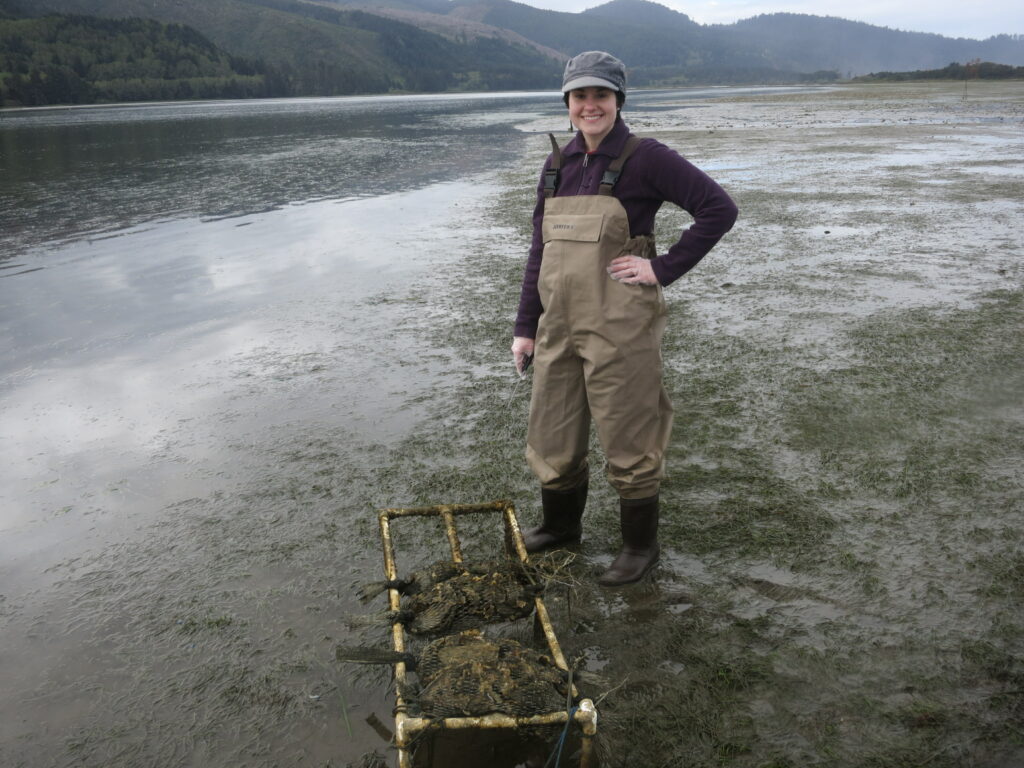Hello! I am a new fellow so I’ll start by introducing myself and my background. My name is Amy Ehrhart and I am the Aquaculture Fellow for Oregon Sea Grant. I started this position in November 2020 part-time while I finished my PhD in Environmental Science and Management at Portland State University. I was about two weeks away from my defense when the position began which made for a whirlwind of a month. But somehow I was able to defend, edit and submit everything on time. It feels surreal to be done with graduate school and starting a fellowship, especially during a pandemic.
So how did I get into aquaculture? My dissertation research focused on pharmaceutical contaminants in coastal ecosystems. Two of my research chapters addressed effects and accumulation of these compounds in Pacific oysters, which are commercially grown in Oregon and Washington. To conduct field experiments, I used off-bottom rack-and-bag culture methods (see picture below) to grow oysters in areas near and far from contaminant sources. While aquaculture was not the main focus of my research, I gained a good understanding of oyster biology/ecology, different growing methods, areas where culture is taking place, and some industry priorities. Since starting the fellowship I have learned A LOT more about aquaculture in Oregon and the West coast and I am enjoying the deep dive into this topic.

So far in my fellowship I have focused on three main projects: conducting a landscape analysis, planning a needs assessment, and participating in a regional seaweed aquaculture collaborative. I also provided updated content for the Oregon Sea Grant aquaculture website to highlight these current endeavors. There hasn’t been a large focus on aquaculture at Oregon Sea Grant for a few years so there was a need to identify who the major players are in the industry. I was tasked with completing a “landscape analysis” or more simply put, a spreadsheet of people, groups, and agencies involved with marine aquaculture in Oregon. I spent a good portion of my time compiling this information, and I continue adding to it as my work continues.
My second project involved planning a needs assessment for growers, prospective growers, agencies, and researchers working on aquaculture topics. Globally, about 50% of seafood comes from aquaculture (NOAA Fisheries), and a lot of this is imported to the U.S. from other countries. There is federal support for coastal states to increase domestic aquaculture production, but they face several challenges and barriers. Oregon aquaculture production is fairly low compared to other states, and there is a potential opportunity for expansion, which could provide significant economic benefits for the state. But we don’t know if there is interest in expansion in marine aquaculture or what the current challenges are for growers. The goal of the needs assessment is to identify needs and barriers surrounding aquaculture expansion and use this information to inform outreach and engagement strategies. I am currently finalizing an online survey that will be distributed as soon as it gets human subjects research approval.
My third project has been participating in a collaborative group that represents California, Washington, Oregon, and Alaska with a focus on seaweed aquaculture. Seaweed is a relatively new product, and one that I knew very little about coming into this group. I have been working hard to catch up so I can contribute meaningful recommendations. Our goal is to plan a regional symposium on seaweed farming that will be beneficial to growers and other industry members in all west coast states. This is incredibly challenging as all of the states have highly variable regulatory requirements, environmental constraints, and current seaweed operations. In Oregon, seaweed aquaculture is in the very early stages and constitutes 2-3 growers that cultivate Pacific dulse seaweed in land-based tanks. This is very different from a state like Alaska, that produces large amounts of kelp in the offshore environment. Identifying topics and strategies that apply to all states at a regional level has been an interesting challenge, and I look forward to strategizing and learning more.
These first three months of my fellowship have flown by and I am really enjoying the work! It was difficult to start a job with a heavy focus on stakeholder engagement during a pandemic that restricts in-person interactions, but I am feeling much more optimistic about the future as vaccines are being administered and COVID-19 cases are starting to drop.
Thanks for reading and stay safe out there!


Thanks for your post, Amy! It sounds like you have indeed had a very busy few months between finishing your PhD, starting a fellowship, and getting up to speed on the Oregon aquaculture industry! Congrats on all of it and I look forward to learning more about the future of aquaculture in Oregon!
Extremely proud of you Amy…I always knew you had greatness in you.